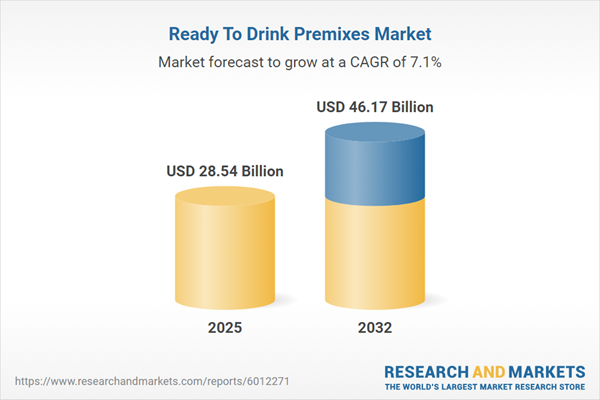Speak directly to the analyst to clarify any post sales queries you may have.
The ready to drink premixes market is advancing rapidly, driven by shifting consumer preferences, product innovation, and regulatory evolution. Industry leaders must prioritize strategic decisions to harness the momentum and capitalize on emerging opportunities.
Market Snapshot: Ready to Drink Premixes Market Size and Growth
The Ready to Drink Premixes Market grew from USD 26.63 billion in 2024 to USD 28.54 billion in 2025. It is expected to continue growing at a CAGR of 7.11%, reaching USD 46.17 billion by 2032. This robust trajectory reflects high consumer demand for convenient, customizable beverages globally, positioning the sector for continued expansion and innovation.
Scope & Segmentation of the Ready to Drink Premixes Market
This report provides comprehensive coverage and detailed segmentation, helping strategists and decision-makers identify high-potential growth areas.
- Type: Alcoholic, Beer, Spirit, Wine, Non-Alcoholic
- Packaging: Bottle, Can, Carton
- Flavor: Citrus, Cola, Fruity
- Formulation: Regular, Sugar-Free
- Form: Concentrate, Liquid, Powder
- Application: Bakery & Confectionery, Beverages (Cold Beverage, Hot Beverage), Dairy Products, Pharmaceutical
- Distribution Channel: Direct-To-Consumer, Off-Trade, On-Trade
- Region: Americas (North America: United States, Canada, Mexico; Latin America: Brazil, Argentina, Chile, Colombia, Peru), Europe, Middle East & Africa (Europe: United Kingdom, Germany, France, Russia, Italy, Spain, Netherlands, Sweden, Poland, Switzerland; Middle East: United Arab Emirates, Saudi Arabia, Qatar, Turkey, Israel; Africa: South Africa, Nigeria, Egypt, Kenya), Asia-Pacific (China, India, Japan, Australia, South Korea, Indonesia, Thailand, Malaysia, Singapore, Taiwan)
- Company Coverage: The Coca-Cola Company, PepsiCo, Inc., Nestlé S.A., Diageo PLC, Asahi Group Holdings Ltd., San Miguel Brewery Inc., Bacardi Ltd., Boston Beer Corporation, Halewood Laboratories Pvt. Ltd., Mangalam Enterprise
Key Takeaways for Senior Decision-Makers
- Demand is underpinned by evolving lifestyles and preferences for on-the-go solutions, driving brands to prioritize both convenience and quality.
- Innovation remains central, as functional and wellness-oriented ingredients are increasingly incorporated into both alcoholic and non-alcoholic premixes to address health-conscious consumers.
- Packaging and sustainability concerns are influencing format choices, with glass, metal, and sustainable carton options providing distinct benefits in premiumization, recyclability, and portability.
- Regional dynamics show that mature markets focus on sophisticated blends and clean labels, while emerging markets leverage local flavors and e-commerce channels for differentiation and reach.
- Strong digital engagement and data-driven strategies are essential to tailor marketing, optimize distribution, and enhance customer retention across global markets.
- Strategic partnerships, supply chain resilience, and agile sourcing are vital as the landscape adapts to regulatory and external pressures.
Tariff Impact on International Supply Chains
Recent United States tariff measures have meaningfully disrupted global supply chains by increasing costs of imported components and inputs. Brands are mitigating these pressures by diversifying procurement, accelerating regional sourcing, and optimizing upstream relationships. These shifts underscore the importance of agility, proactive cost management, and transparent value communication to consumers, particularly when adjusting pricing strategies in response to tariff-driven cost structures.
Methodology & Data Sources
This analysis synthesizes primary and secondary research, including executive interviews, structured surveys, regulatory documents, trade journals, and proprietary databases. Data integrity is maintained with expert peer reviews, triangulation of sources, and statistical validation to ensure robust and strategic market foresight.
Ready to Drink Premixes Market: Why This Report Matters
- Enables data-driven portfolio decisions by revealing key segment trends, region-specific drivers, and nuanced channel insights across the ready to drink premixes market.
- Identifies the competitive landscape and innovation strategies of market leaders, empowering leadership teams to benchmark effectively and refine go-to-market tactics.
- Supports scenario planning for tariff, regulatory, and supply chain disruptions so organizations can anticipate changes and prioritize resilient, value-generating strategies.
Conclusion
The global ready to drink premixes sector is charting a path shaped by innovative formulations, agile supply strategies, and evolving regulatory trends. Progressive companies that integrate consumer insights and operational flexibility will secure durable market advantages.
Additional Product Information:
- Purchase of this report includes 1 year online access with quarterly updates.
- This report can be updated on request. Please contact our Customer Experience team using the Ask a Question widget on our website.
Table of Contents
3. Executive Summary
4. Market Overview
7. Cumulative Impact of Artificial Intelligence 2025
Companies Mentioned
The companies profiled in this Ready To Drink Premixes market report include:- The Coca-Cola Company
- PepsiCo, Inc.
- Nestlé S.A.
- Diageo PLC
- Asahi Group Holdings Ltd.
- San Miguel Brewery Inc.
- Bacardi Ltd.
- Boston Beer Corporation
- Halewood Laboratories Pvt. Ltd.
- Mangalam Enterprise
Table Information
| Report Attribute | Details |
|---|---|
| No. of Pages | 181 |
| Published | October 2025 |
| Forecast Period | 2025 - 2032 |
| Estimated Market Value ( USD | $ 28.54 Billion |
| Forecasted Market Value ( USD | $ 46.17 Billion |
| Compound Annual Growth Rate | 7.1% |
| Regions Covered | Global |
| No. of Companies Mentioned | 11 |









